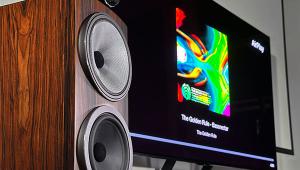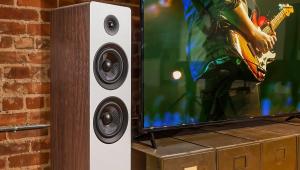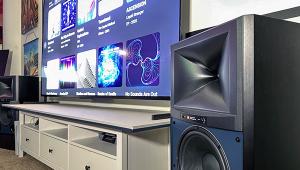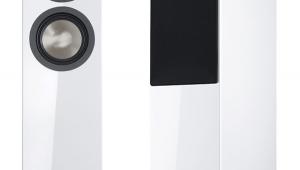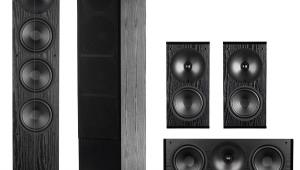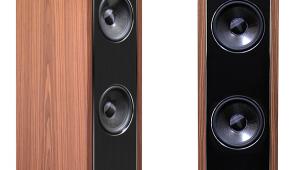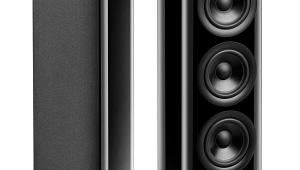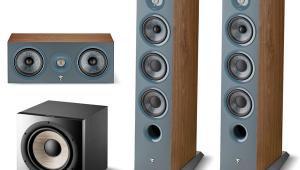MartinLogan Motion 40 Speaker System

At A Glance: Folded Motion tweeters • Dual 6.5-inch aluminum cone woofers • Custom five-way bi-wire tool-less binding posts
A couple of years ago, I took a tour of the Ben & Jerry’s ice cream factory in Waterbury, Vermont. (Somehow, it lessens the soul-soothing delight that is ice cream when you talk about it being churned out of a factory. I would rather think of it as being collected soft-serve straight from the udders of Antarctic dairy cows that graze exclusively on fresh-fallen snow, drink pure thousand-year-old glacier water, and make the sound of ice cream truck bells when they moo.) Whilst there, I heard the tour guide refer to Ben & Jerry’s ice cream as super-premium. I was intrigued because: 1) I’m thinking about using it as a nickname for myself; 2) I’d never heard the term used in reference to ice cream before; and 3) I wondered if there were additional levels of premium-ness. (Ultra-super premium? Super-duper premium? Maximum-ultra-super-duper premium?) I was disappointed to discover that, although the FDA sets standards for the use of nutrient descriptors—such as light, reduced fat, and lowfat—the terms economy, regular, premium, and super-premium don’t have hand-packed definitions and are merely made-up marketing terms that vary from brand to brand. Evidently, it has to do with both the amount of air mixed into the ice cream and the content of butter fat in the recipe. Less air and more butter fat promotes higher premium-ness—all the way up, I assume, to the heart-valve-clogging, airless, 100-percent pure, frozen-block-of-butter-fat variety.
In the case of loudspeakers, it’s the opposite. More air and less fat—no one likes tubby bass—results in super-smooth, premium sound. (Think of distortion as the audible equivalent of freezer burn.) Similar to the official nutrient descriptors for ice cream, there are set parameters by which loudspeakers are measured and, on a basic level, can be compared: frequency response, efficiency, blah, blah, and blah. But whether it’s frozen dairy treats or the reproduction of music beats, the recipes and the quality of the ingredients used can vary dramatically from brand to brand—and even within a brand if they offer designs running the gamut from economy to super-premium.

Daddy’s Got a Squeezebox
Since it began in the early 1980s, MartinLogan has always crafted loudspeakers that by almost anyone’s definition would fit in the super-premium category; and sometimes, such as with the $120,000/pair Statement E2 speaker system in the late 1990s, they’d dabble in the maximum-ultra-super-duper-premium realm. The hallmark of a MartinLogan speaker has always been the seductively smooth, revealingly open, lighter-than-air quality of sound that came from the company’s near-exclusive use of electrostatic transducers to reproduce the mid and high frequencies. In 2010, however, to the horror of many MartinLogan devotees who feared it would be the beginning of the end, the company introduced what could be considered a range of MartinLogan light or regular speakers—with prices starting at $200/each for the compact Motion 2 monitor. Instead of electrostatic panels, MartinLogan’s new Motion series speakers used a newfangled take on an oldfangled idea for a tweeter with a pleated diaphragm material. (MartinLogan calls the tweeter design Folded Motion.) Almost as scandalous was the use of (gasp!) cone drivers to cover the midrange.
As it happens, the speaker gods did not rain down fire and brimstone on the MartinLogan headquarters in Lawrence, Kansas. (Last summer, it pretty much didn’t rain at all in Kansas, but I doubt it had anything to do with loudspeaker design.) As a result of extraordinary engineering brilliance or the application of ancient Masonic secret knowledge, MartinLogan’s 1 x 1.4–inch Folded Motion tweeters are uncanny in their ability to closely mimic some of the best aspects of a true electrostatic panel transducer: excellent transient response, high dynamic contrast, and relatively low distortion. For those who aren’t familiar with MartinLogan’s Folded Motion technology, the basic concept is to take a 5.25 x 1.75–inch piece of super-light/thin diaphragm material with an attached conductive grid and fold, or crease, it into a series of tiny pleats resembling the side of an accordion. Rather than move in and out as typical driver designs do, the pleats in the diaphragm material are compressed and pulled apart edgewise—again, similar to an accordion. This action squeezes air, sending compressed and rarefied waves into the room. (SqueezeBox tweeter would have been much catchier than Folded Motion.) The design is highly efficient; thanks to the pleating of the diaphragm, it has a sound-producing surface area that’s about eight times more than a typical 1-inch dome tweeter while requiring almost 90 percent less excursion than that traditional dome tweeter.
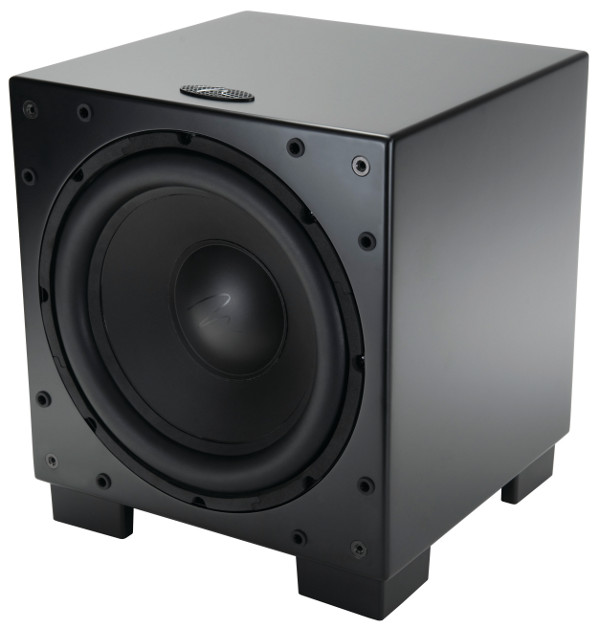
Nothing to Gloss Over
Currently, MartinLogan uses the same Folded Motion tweeter in every Motion Series speaker model, including the newly minted Motion 40 towers ($950/each), the Motion 30 center ($650), and the Motion 15 monitor ($800/pair) that the company sent for this review—plus a Dynamo 1000 wireless subwoofer ($1,000). In addition to sharing the same tweeter, the new Motion Series speakers have similar cabinet styles with a gorgeous high-gloss Piano Black finish, softly rounded edges, gently sloping top panels, and MartinLogan’s finger-friendly custom five-way tool-less binding posts. Each speaker utilizes a ported design along with magnetically attached metal grilles. The grilles are slightly indented in front of the tweeter, a feature that serves to highlight its soft-golden color. Also behind the grilles are aluminum cone mid- and low-frequency drivers that range in size from 5.25 inches to 6.5 inches depending on the model.
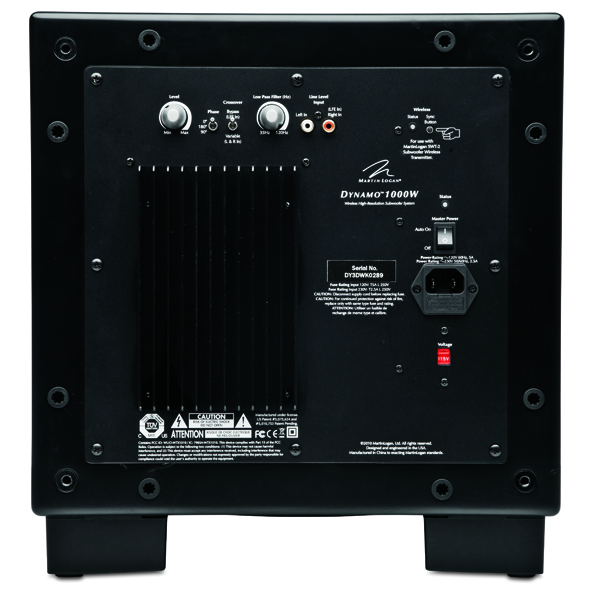
MartinLogan’s Dynamo 1000 subwoofer’s sealed cabinet has a matte black finish rather than high-gloss and hides a 500-watt internal amp and a 12-inch cone driver. In addition to a built-in wireless receiver, the subwoofer ships with an SWT-2 transmitter that attaches to the sub output of your AVR or surround processor. You can go old school and use the sub’s line-level inputs, but there are no old-old-school speaker-level inputs. Including the wireless transmitter with the subwoofer (rather than selling it as an optional upgrade) isn’t the only unusual and very appreciated aspect of the Dynamo 1000. Although it’s configured as down-firing when it comes out of the box, the Dynamo 1000 can quickly be converted—without any tools other than your hands—to a front-firing orientation by moving the four pedestal feet from the side of the cabinet with the 12-inch driver to the side with the input/control panel and attaching the black-cloth-covered grille to what is now the front of the subwoofer cabinet. The dual-configuration capability and instant wireless-ness make the Dynamo 1000 extremely easy to adapt to a wide variety of unique installation situations.


